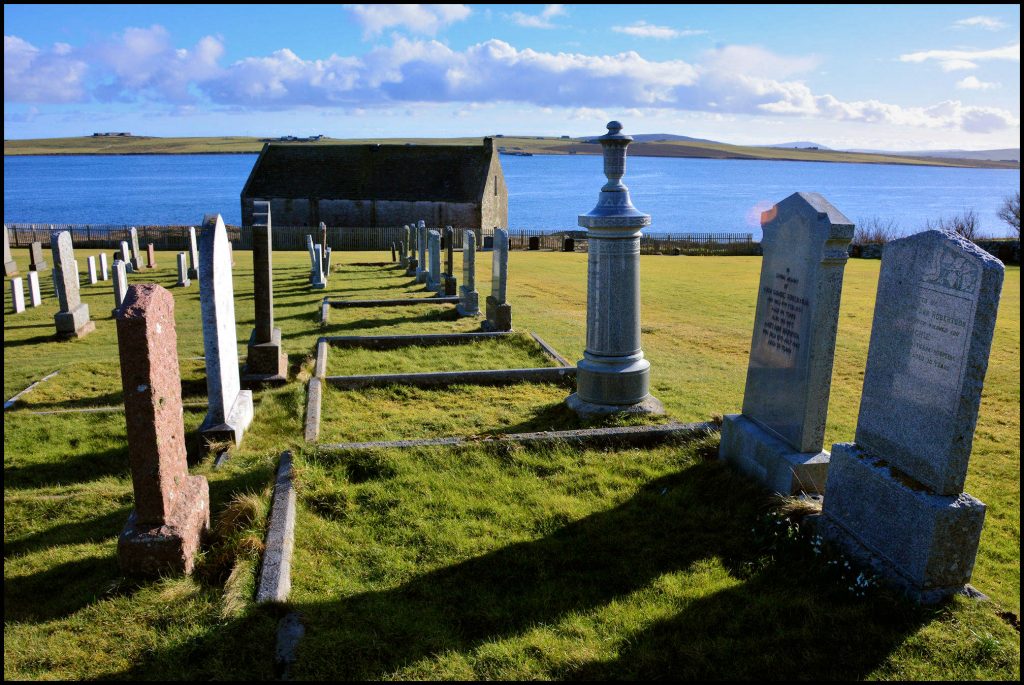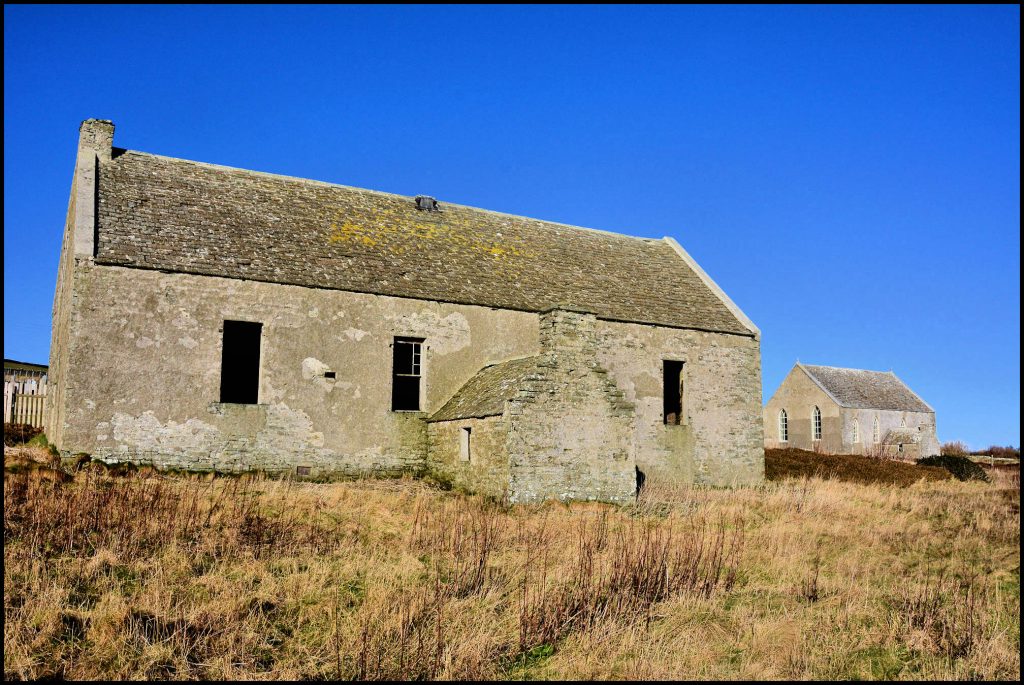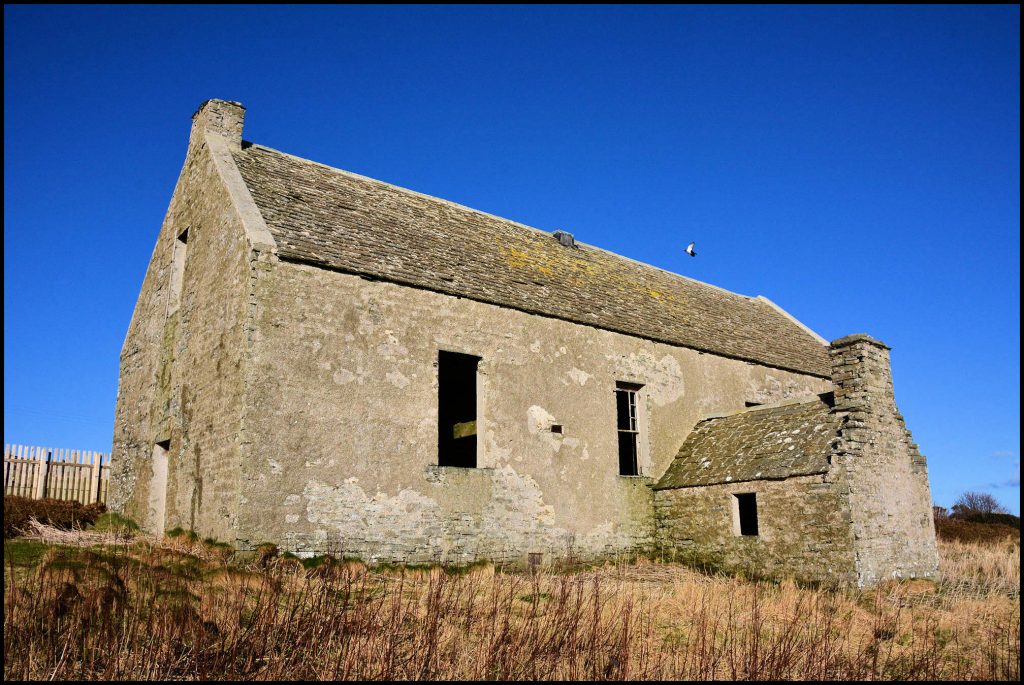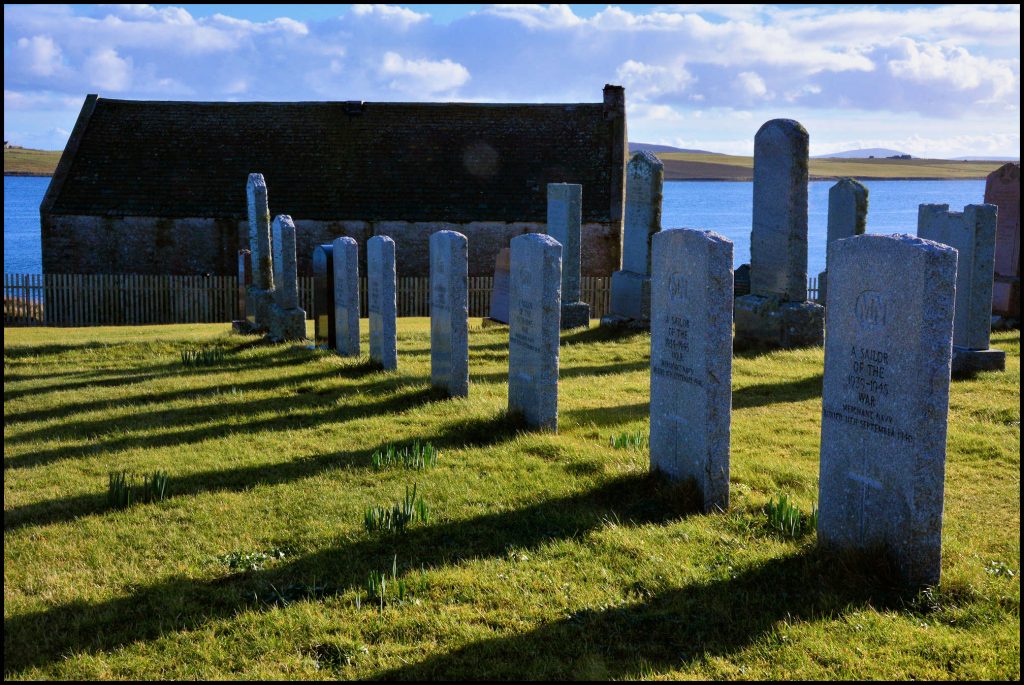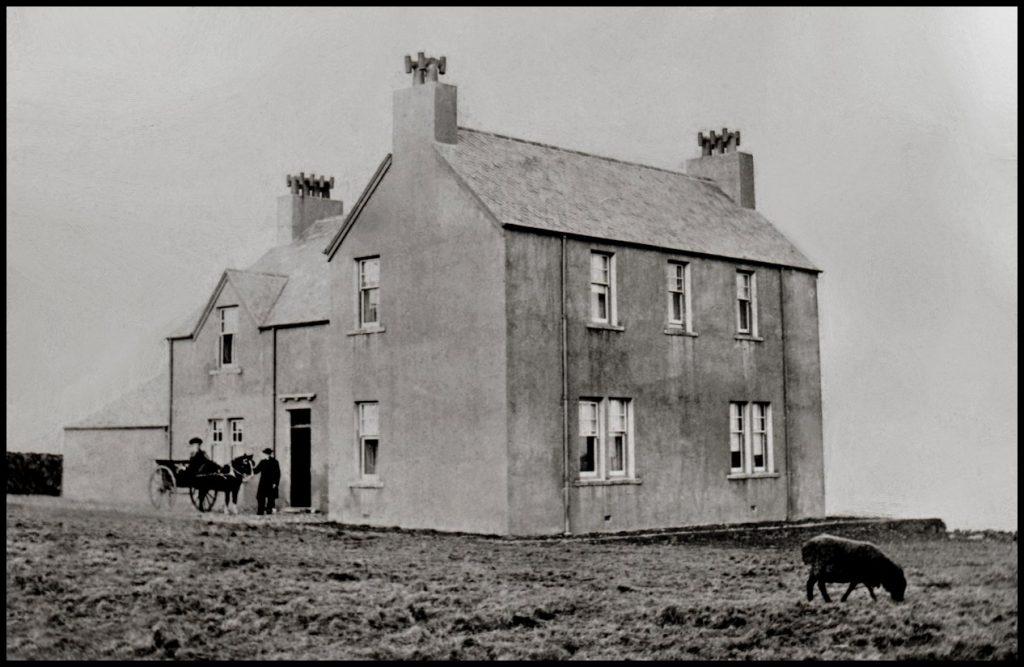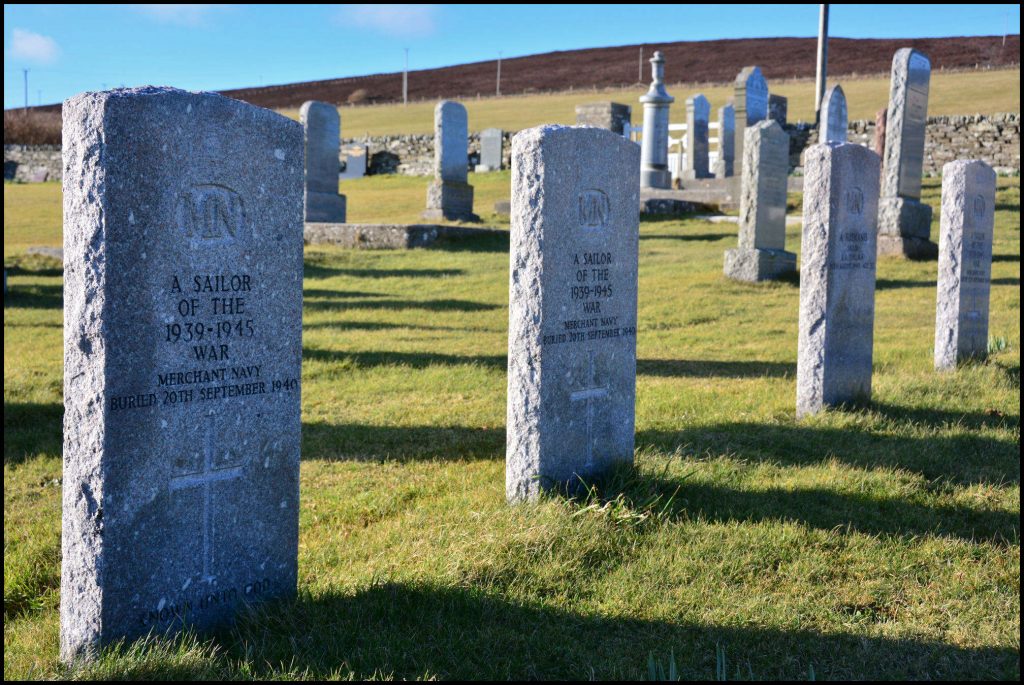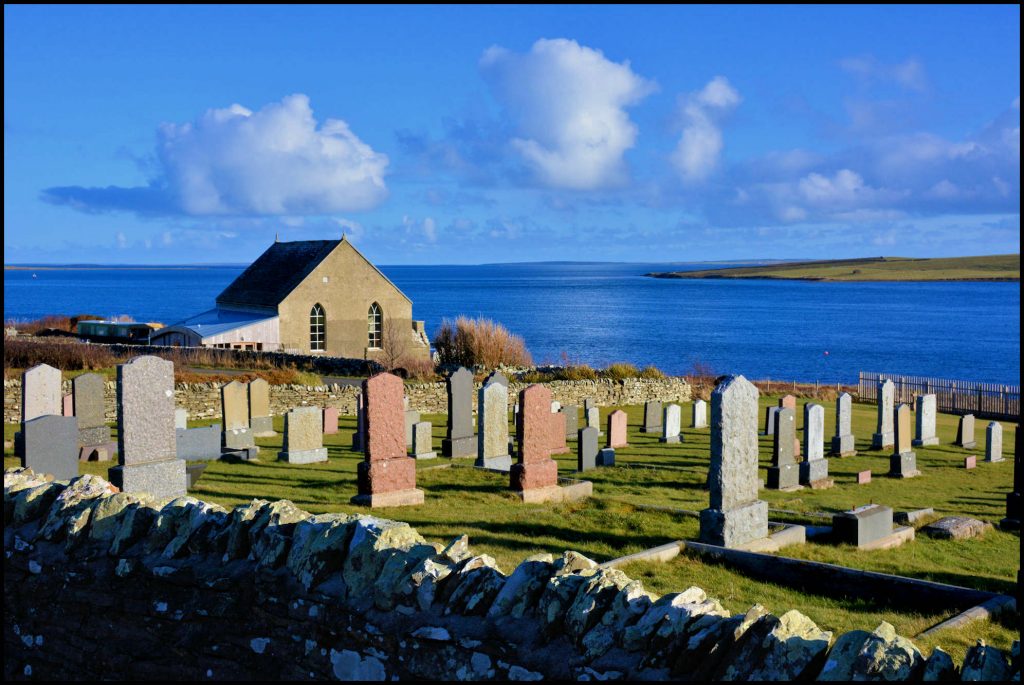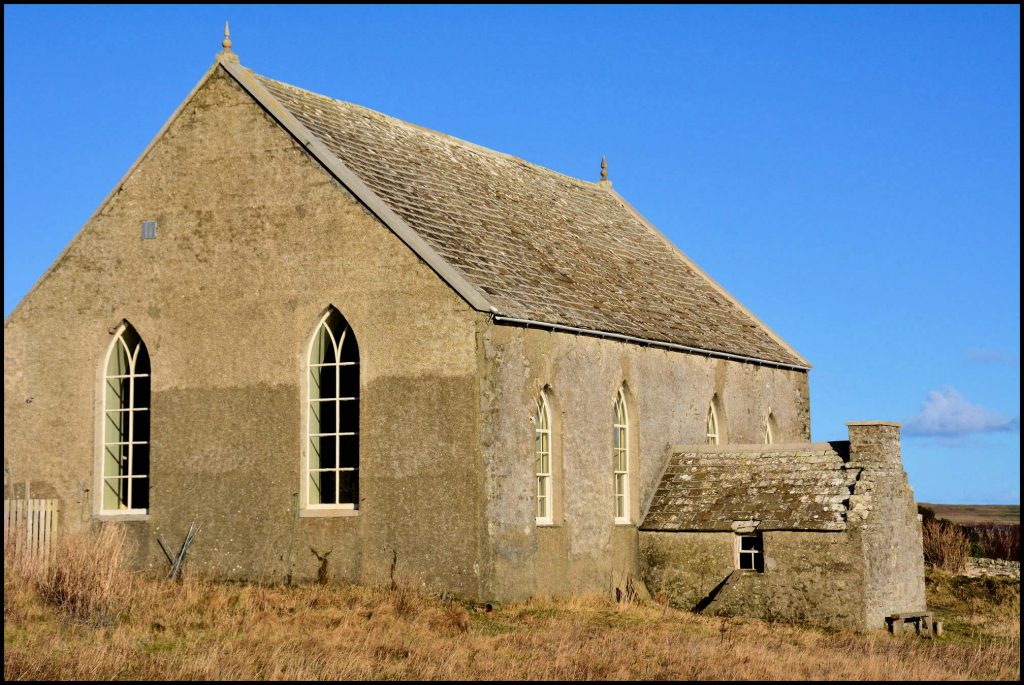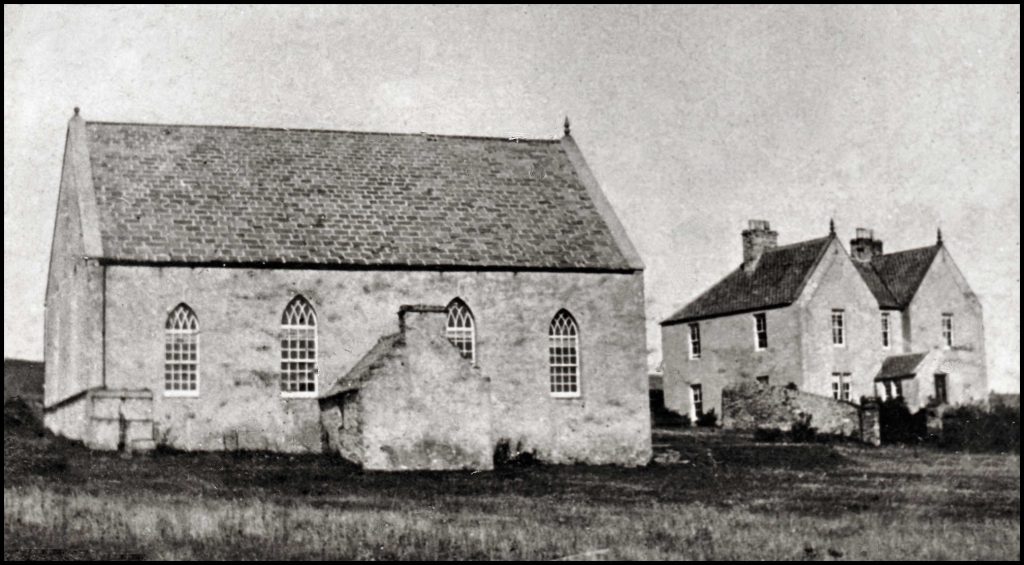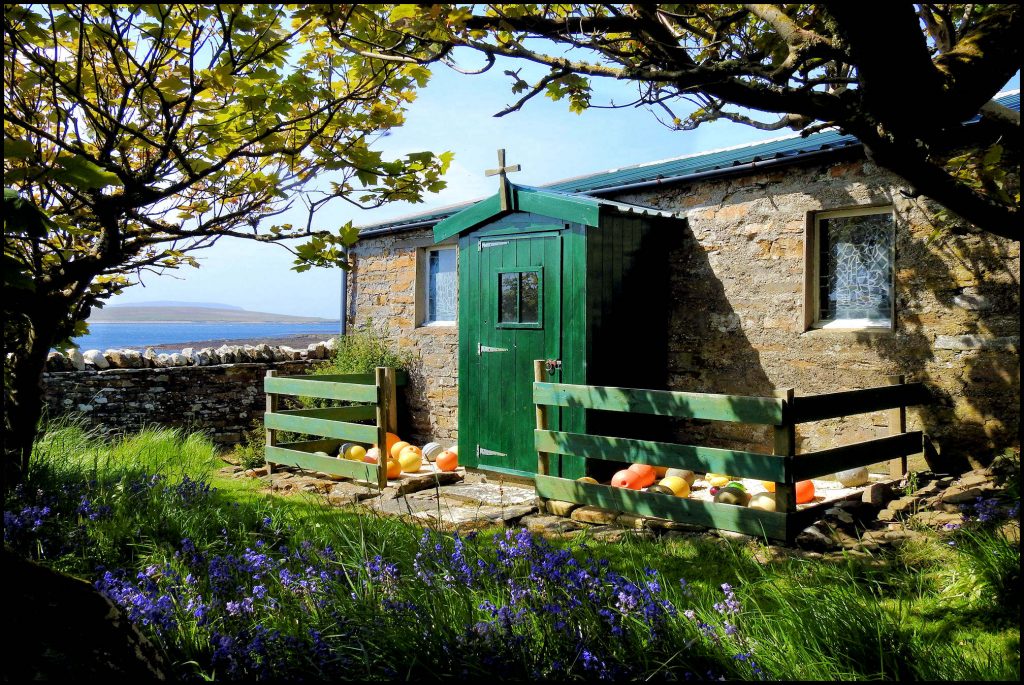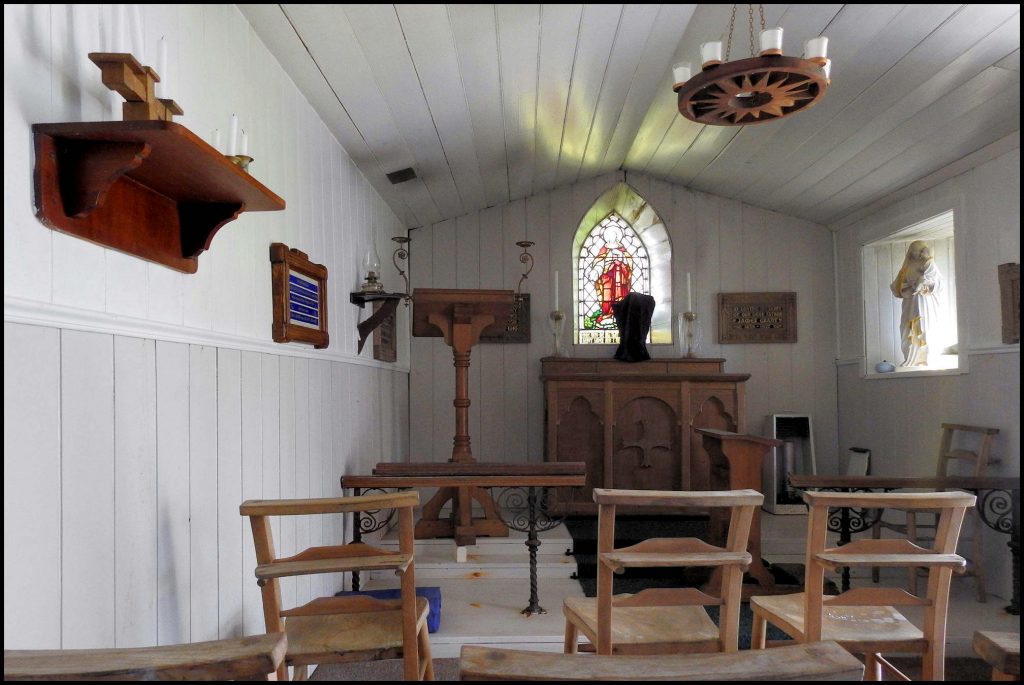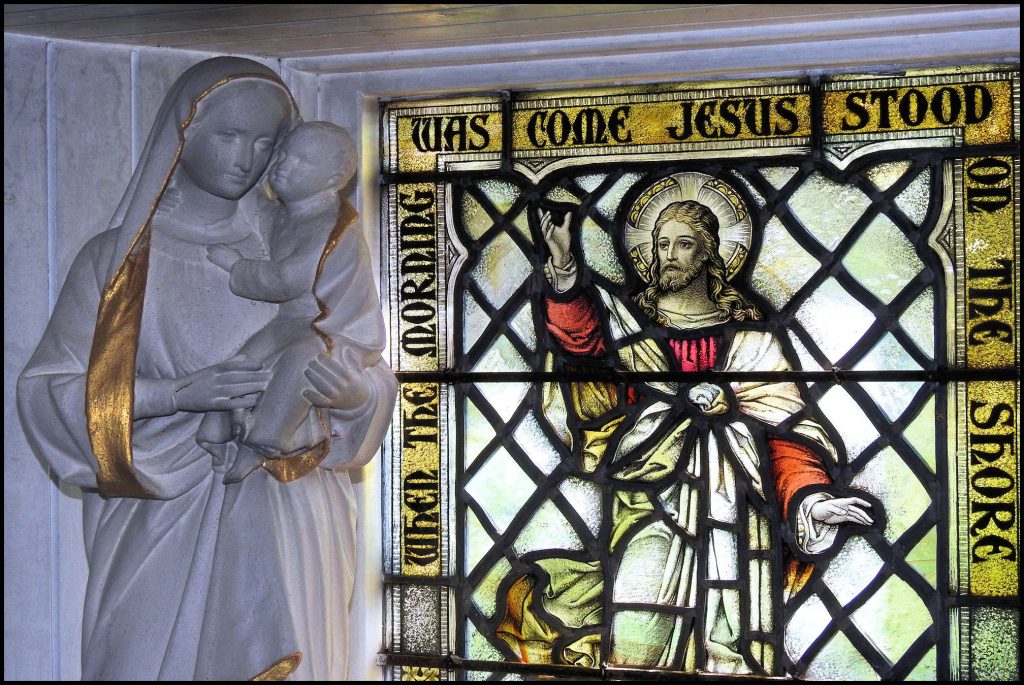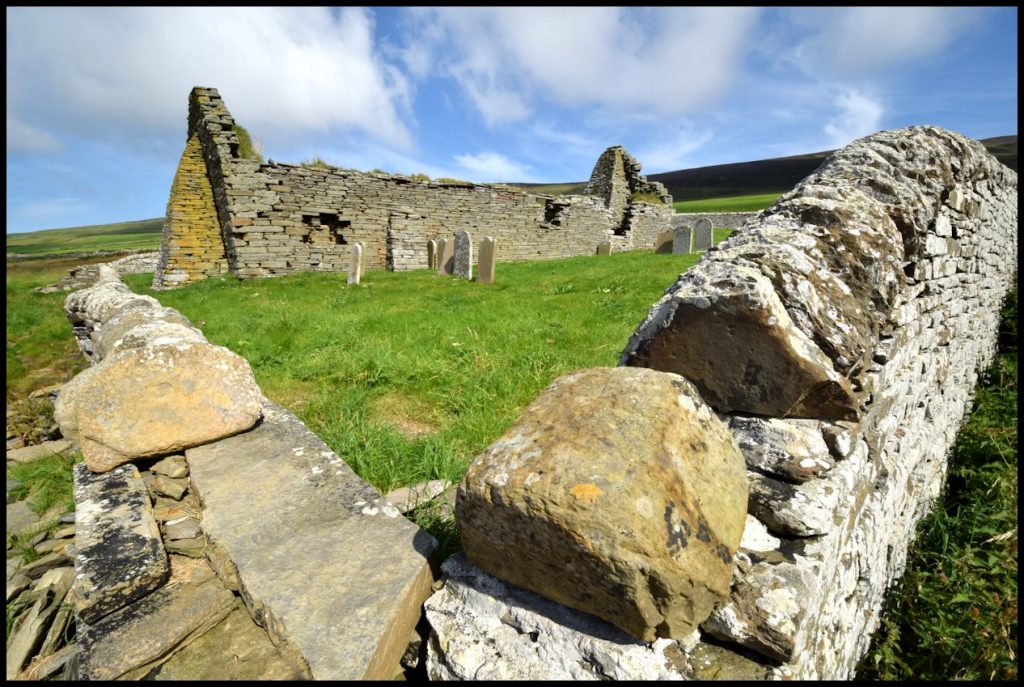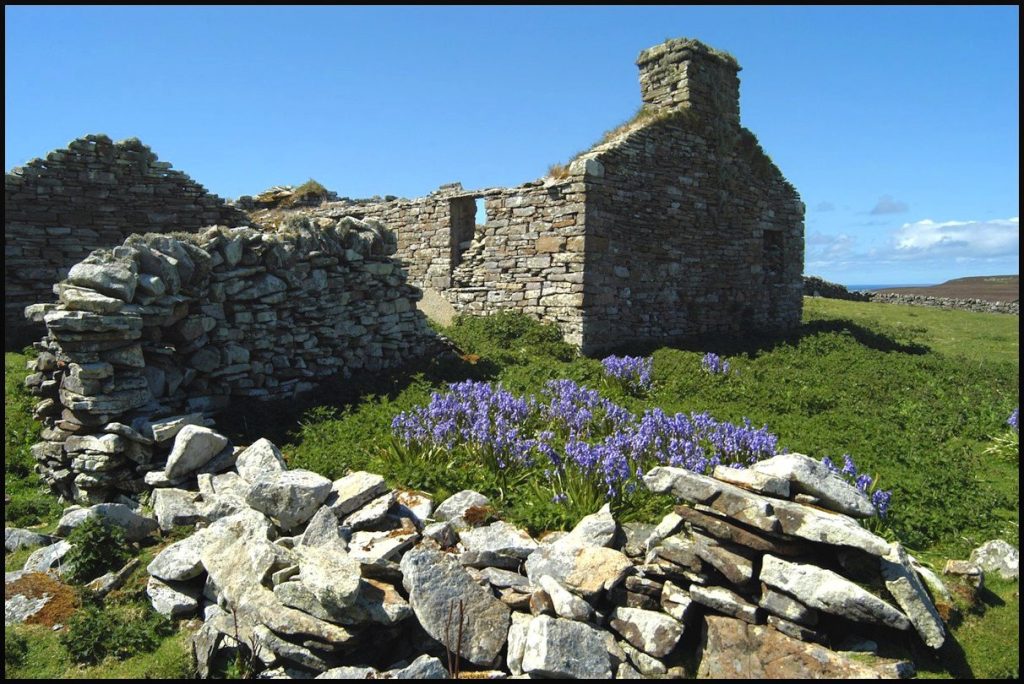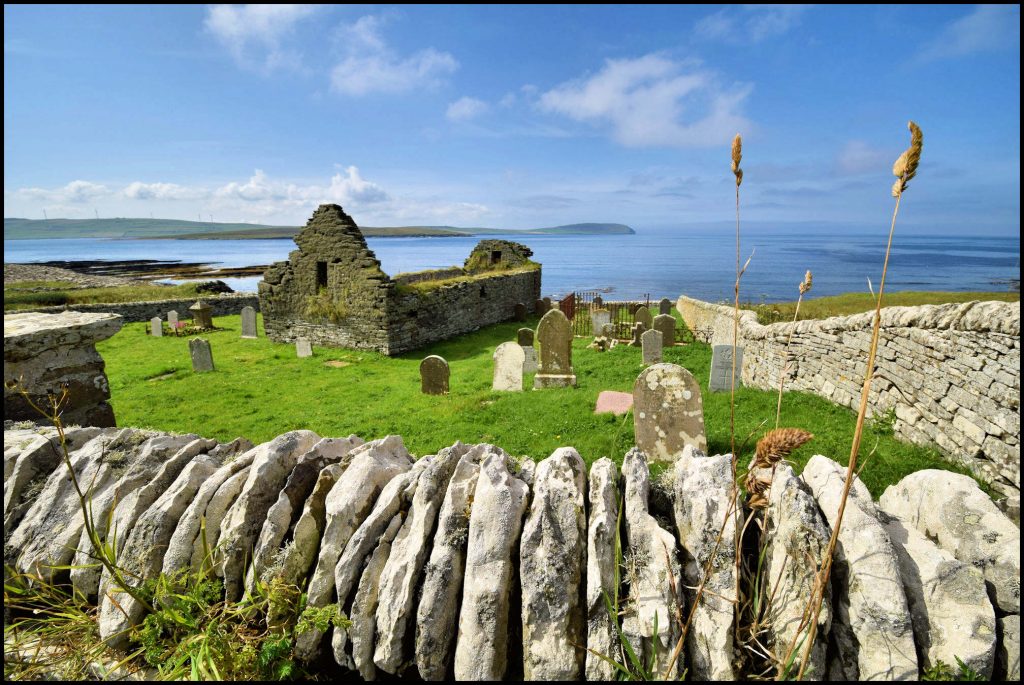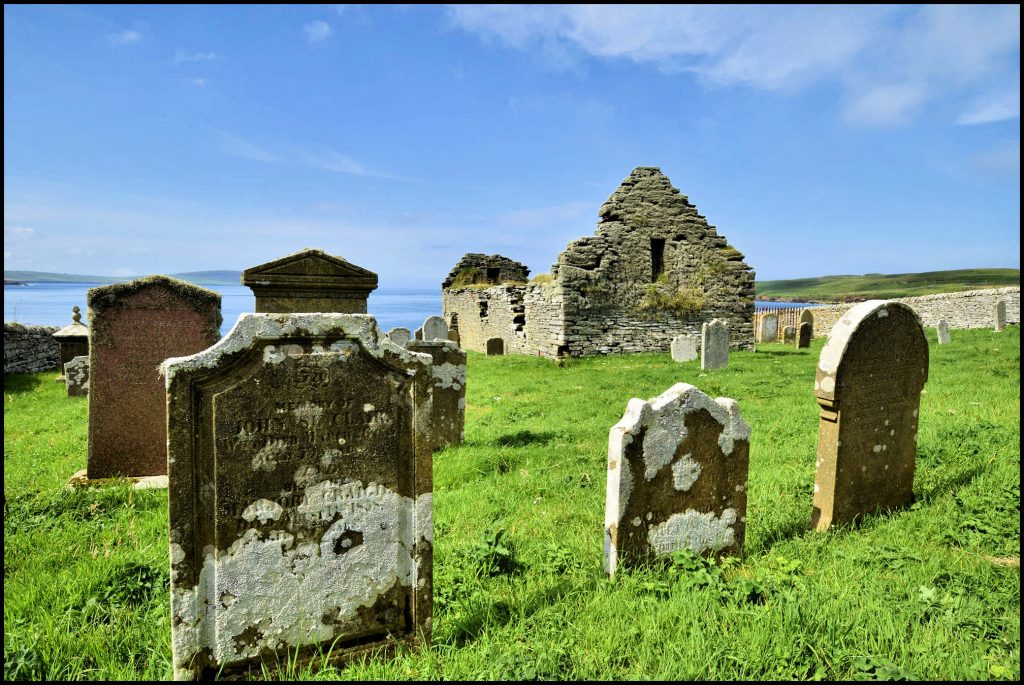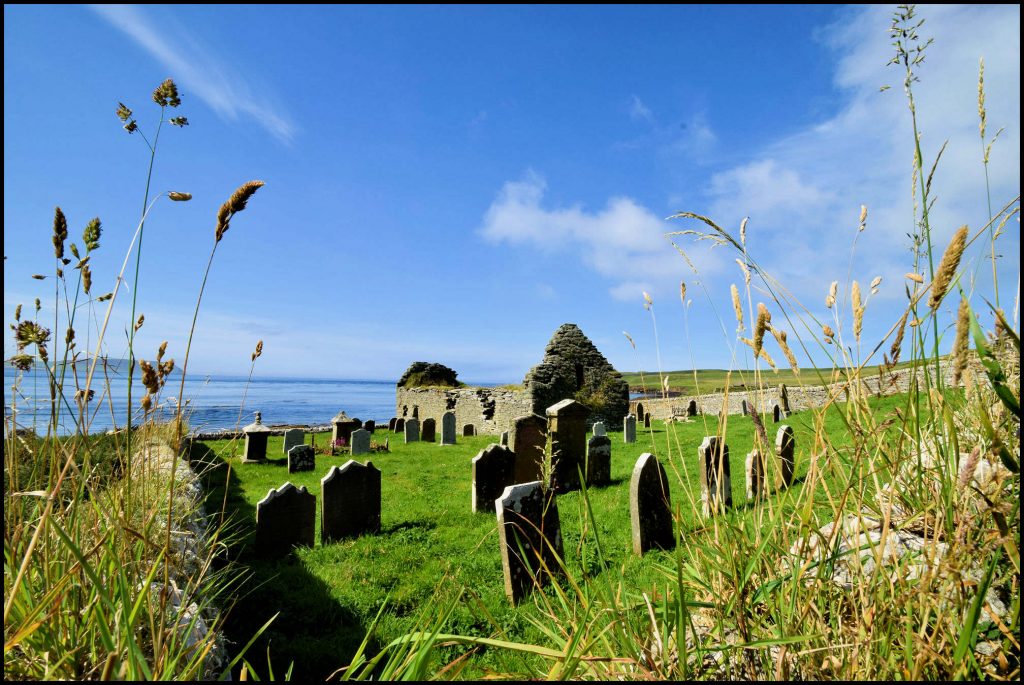The Kirks and Kirkyards of Rousay, Egilshay and Veira – Part 3
by
Tommy Gibson
A new kirkyard for Sourin and Frotoft was needed by the end of WW1. A site in the Brinian, at the Old Established Kirk was found. This was an area of about one and a half acres. Only about a half acre section was first used. This was to the east of the main gate. The first interment was in 1919. In the early sixties most of the ground was still old grass and heather, so some of the Kirk members ploughed and reseeded the rest of the ground. The ground to the west of the gate is now in use.
In the Brinian the two Kirks were the United Presbyterian and the Old (Established) Kirk. The Old Kirk was built around 1815. It is not known if that if a Church was already there but I suspect no. This Kirk was a well built building and even yet it stands as square today as the day it was built. The roof looks as good as new but I suspect in poor condition. There has been 3 doors into the building, one on the west end another on the east end but this one has been built up. There is an Oak lintel above this door, 18 inches wide, 4 inches deep, and 10 feet long. The third is through the porch. A small fireplace was next to the pulpit on the right side but there is no evidence of a chimney. There is a chimney on the west end but no fireplace. I wonder how these fires worked. There was also a fireplace in the middle of the building with a cast iron flue pipe.
Over the years I suspect that changes and improvements took place in this building. Originally there was a flagstone floor and this was later wooden. There is also four air vents on the main walls. They were covered by small ornate wooden boxes in the inside. Only three remain. Four large wooden beams brace the walls near the roof, and a very large beam still remains that was the bottom of the balcony. There were five rows of seats up there with a stairway to the left of the door. Six windows filled the place with light. Four on the south side and one each end, both high up. The pulpit had a large back but the actual pulpit itself was of a standard size. The last time the inside of the Kirk was painted, the walls and all the timber were painted pink, fortunately the roof was white. A small porch is situated on the lower side of the Kirk. A small window and a fireplace completes this small room.
The manse for this Kirk is at the Glebe, and had the largest membership when it was built. A few years later it was the smallest. One of the Ministers was the Rev. James Gardener. He came to Rousay in 1844 and did his pastoral duties for 42 years. He died in on the 28th March 1885 aged 82. It seems to me that the ministers liked Rousay. They did long years of service to the public. The Rev. McLellan 37 years, Ritchie 21 years, Rose 23 years. Long Service indeed. This Kirk was closed in the late 1920’s.
A story concerning Rev. Gardener; At the school of Rousay, on 19th April 1853, the session met and constituted. (This was most probably the Westside School). The Moderator was the Rev James Gardener and Messers Reid and Kirkness, Elders. Barbara Louttit (from Blackhammer), appeared and stated that she had given birth to a child….. to William Wood residing at Walliwall near Kirkwall was the father and that he had left the country. The moderator was asked to write to …..?….. in Kirkwall on the subject and report at the next meeting. Barbara Louttit was admonished and dismissed for the present. The meeting was closed with prayer. At the church in Rousay, 30th April 1854, the session met again. A letter from a Dr. Logie from Kirkwall was read and stated that W. Wood had indeed left the country. Barbara was in attendance and was questioned about the father of her child. She again was admonished and dismissed for present. A third meeting was called on the 6th of May 1855. Barbara Louttit craved baptism for her child. Being interrogated she again solemnly declared that William Wood was the father of the child. Again she was rebuked and seriously admonished before the session for the act of fornication, and informed her that she was absolved and was admitted back to the church privileges. This must have been a trying time for the girl. Over two years of meetings and rebukes, public scandal on top of this. She paid dearly for her son. Her son William Louttit married my grandfather’s sister, Margaret Gibson, and they had three of a family. They had a son William who took poorly when he was 6 and his father and a neighbour took a boat from Westness to Evie for medicine from a Doctor. They were both drowned half way across. William died from appendicitis at Broland in 1896 when he was 14.
I do not know when the services stopped in the Established Church. They may have gone on longer than 1929, when the Union came. In the Sixties many Kirks were sold all over the Country. Meetings were held in Rousay to see about the possibility of selling the Old Kirk. Some of the members of the Old Kirk were still alive then and were horrified about the prospect of selling the Kirk. The old aligns was still there and most of them would have rather die then sell of the Kirk. It still remains an empty building.
Rousay United Secession Church. (The U.P.) This was an offshoot of the Kirkwall congregation. Some Rousay people were members of Mr. Paterson’s congregation and moved for a church in 1833. A congregation was formed and a church was built in 1834 free of debt. A commemorated token to mark this event was struck. A manse was built immediately thereafter. Four years passed before they got a minister, The Rev. John McLellan who was ordained in 1837. He then ministered to the wants and needs of the congregation for 37 years. McLellan was a powerful preacher and, with revivalist influence strong throughout Orkney, he quickly built up a membership to 170, with an average Sunday attendance of 250. He died in 1874. After a short vacancy Mr. Alexander Allardice was called and settled, but after a brief ministry he was removed by death. He held the position for 6 years. The last minister was the Rev. Alexander Pirie who was called in 1883. He retired in 1914. The church had undergone several alterations and was now a serviceable building. This Church was finally closed in 1995. Six years later the windows on the south side of the Kirk were blown out. It is now in a sad state of repair.
The manse, slightly more an ordinary house, having been damaged by lightning, was replaced by a new commodious house. This being the present manse. This was in 1883 built at a cost of £900. The contract was awarded to Alexander Gibson, Vacquoy who had built the Wasbister School and schoolhouse. Most of the money came from the presbytery in Kirkwall. This manse later became the residence of the Rousay Doctors and was renamed Brinian House. Up to about 1964 the doctor used one of the rooms in the house as a surgery and dispensary. No facilities for a waiting room, the patents had to wait in the kitchen. A wooden building was erected to the west side of the house for a surgery and waiting rooms. This lasted till 1999 when a new modern surgery was built separately from the house. In the early sixties this church became the only regular working church in Rousay. After the union in 1929 Rev. Robert R. Davidson was the minister of the United Churches. A well-liked and respected minister who was formerly a medical missionary in Africa, he was in the Cold Coast, which was later Ghana. He lived in the West Manse at the Glebe. I remember he had a wireless aerial between the chimneys of the manse – a two-storey house. This needed regular inspection; the Rev. Davidson would go up to the roof and walk between the chimneys unaided. We all thought that he had nerves of steel. He left Rousay in 1952 to retire in Holm where he died in 1963 aged 79. His housekeeper was a Miss Morrison, who came from Stronsay. The Rev. Beattie was the next minister. He was an ex. RAF padre. He married while in office in Rousay and left about 1961.
Westness House was situated near the farmhouse and was built over the burn. It was quite a modern house of its day. It straddled the burn, and the water washed household wastes away. John Traill of Westness was a Jacobite and after the battle of Culloden Moor, the government of the day punished them. On Friday the 24th of June 1746, one Ben Moody, of Melsetter, sailed from Kirkwall to Westness and set about plundering the House. He ordered the servants to empty the house of the furniture, and then he took a few choice items, loaded this on to the boat then ordered them to set the rest on fire. Next he turned the guns on the house and raised it to the ground. John Traill decided to rebuild the house on the side of the hill above the original site. This was a spot where the ladies of the house went up and sat in the sun. A house was built before 1750 along with a Chapel. Over the years Westness House has been added on to and renovated possibly a lot of times. The Chapel was Episcopalian, and was at the bottom of the garden.
George William Traill was the Laird of the Estate and resided at Westness from 1840 to 1847, an uncle to Frederick Burroughs, who was the laird from 1847 to 1905. It is known that Eliza Burroughs his wife used this Chapel. Over the years it went into a state of disrepair and a green house was constructed at the end of the chapel and the chapel was made into a tool shed. After the break-up of the estate, Walter Grant bought Trumland House for himself and Westness House for his sisters, Mrs. Low and Mrs. Laurie. He removed the greenhouse and had the chapel renovated and also provided the furniture. In 1952 Dr James Firth and family bought Westness House with little or no furniture. Mrs. Grant on hearing that the chapel was being used again returned the furniture, which was a lectern, chairs and the prayer stools etc. Services were usually conducted by the ministers from the Episcopalian church from Kirkwall. This chapel is still occasionally used.
The Westside Kirkyard has a peaceful and pleasant location overlooking Eynhallow. The tide and sea can be very picturesque on a windy day. The church, dedicated to St Mary, was built in the Kirkyard. The building, now roofless, would have been thatched. The west end of the church started to lean out and a buttress was built to stop this. There are a total of 77 headstones upright or laid flat on the ground. There is no evidence of a manse for the minister in the Westside but in Wasbister was a house called the Manse. This was built on the land belonging to the Traills of Westness. The Manse was built c1560 and remained the manse to St. Mary’s till c1746, this was the time the minister was catholic. From c1746 till 1790 it was still a manse, but to the new Scottish dedication of the United Presbyterian. Before 1837 Wasbister was owned by Lord Advocate of Shetland called Lord Zetland (Sir Laurans Dundas C.B.E.) and may have owned the land up to Kirkgate – i.e. the gate to the Kirk lands, so Blackhammer and Kirkgate may have been on Kirk lands. It was then called Lower Blackhammer, and latterly it was reverted back to “The Manse”.
I have also heard that Egilshay folk worshiped there. To get to the Westside they had to sail or pull across to Rousay, and land below the mill. The best way was to walk up by the Sourin burn to the Muckle Water, then making their way down to the Kirk. You must remember that there were no roads of any consequence in those days. When they arrived they would put on their best boots to enter the Kirk. In the wintertime and perhaps even summer, they must have sat through the services very wet. The service would last for up to two and a half hours, then they had to return back to Egilshay. They must have thought it dangerous to sail around to the Westside.
The late George W. Mainland born at Cott in 1898, and writing in 1974: “My mother who was born in 1867, remembers her grandmother Isabella Yorston quite well. She was born at Skaill, Westside. According to her gravestone in the Chapel she died on 25th February l885 aged 95, being a widow of John Mowat from Skuan. This house was on the land of Knarston. My mother used to tell us that she remembered her grandmother’s tales about living at Skaill, and sometimes listening to singing in the Kirk. According to the dates she was about eight years old”. This would have been c1790.
It was the Rev. James Paterson (ordained in Egilshay) who was the last minister for the Westside Kirk. He was ordained in Egilshay c1789. He took a service in Egilshay one week then in Rousay the next. He died on February 2nd 1837. The services were discontinued now. The last interment was in 1917 when Harry Reid was killed in WW1. The Rev Duncan McLaren of Evie officiated in the absence of the Rev. John Dais Logie who was away attending the Assembly. A large number of mourners from Rousay and Longhope attended. The bearers and firing parties were from the O.R.G.A. Territorials; this was on Wednesday May 23rd 1917.
